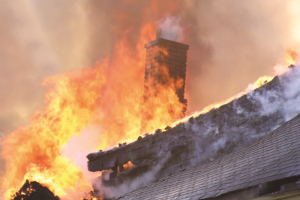
It’s not always this obvious that you’ve had a chimney fire. Call New Buck Chimney Services if you suspect you’ve had one!
Fireplaces are one of the most sought after features in real estate, and more than 30% of homes in the United States use fireplaces, stoves, or other heating appliances. While they add warmth and ambiance to our homes, fireplaces can also come with a serious safety risk – chimney fires.
The Consumer Product Safety Commission estimates that more than 26,000 chimney fires occur in the United States each year. These fires cause more than $120 million in property damage and losses, and can even lead to tragic loss of life. Thankfully, chimney fires can be prevented with proper upkeep and maintenance; however, it is important that homeowners understand why they occur and how to prevent them.
What causes chimney fires?
There are two main causes of chimney fires: creosote buildup and debris in the chimney. Creosote is the primary cause of chimney fires; this sticky, foul-smelling, and highly flammable substance is created in fuel burning fires and can coat the inside of the flue. Thankfully, creosote buildup can be minimized by burning seasoned firewood as well as having the chimney swept at least once per year.
Debris in the chimney can also lead to chimney fires. Dry and brittle leaves, twigs, and even bird nests can quickly ignite if they come in contact with stray sparks or embers. Having the chimney regularly swept – as well as making sure the chimney cap is undamaged – is the best way to eliminate debris in the chimney.
Signs your chimney has experienced a chimney fire
Whether they are large or small, chimney fires can damage your chimney. However, it may be difficult to notice if a chimney fire has occurred. While a major chimney fire may leave flames shooting out of the top of the chimney, a minor or smaller chimney fire may be obscured by the normal smells, sounds, and smokes of the fire. The following are some of the signs from the CSIA that you have experienced a chimney fire.
- “Puffy” or “honey combed” creosote
- Warped metal of the damper, metal smoke chamber connector pipe or factory-built metal chimney
- Cracked or collapsed flue tiles, or tiles with large chunks missing
- Discolored and/or distorted rain cap
- Heat-damaged TV antenna attached to the chimney
- Creosote flakes and pieces found on the roof or ground
- Roofing material damaged from hot creosote
- Cracks in exterior masonry
- Evidence of smoke escaping through mortar joints of masonry or tile liners
Because it is difficult to identify when a chimney fire has occurred with the naked eye, a chimney inspection may be necessary. Level II and Level III chimney inspections, while intensive, can provide the best look as to the condition of your chimney after a chimney fire has occurred.
Preventing chimney fires
Thankfully, chimney fires are entirely preventable. Because clean chimneys cannot catch fire, having your chimney swept and inspected at least once a year is the best way to prevent chimney fires. Likewise, keeping your chimney well maintained and replacing important chimney components such as the chimney cap is another way to ensure that no debris finds its way into the chimney.
If you think your chimney has experienced a chimney fire or you need to schedule a chimney sweeping or inspection, contact New Buck Chimney Services today. Our expert staff can identify the signs that you’ve had a fire as well as remove or repair potential fire hazards to help prevent it from happening again.
